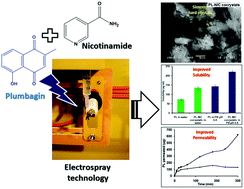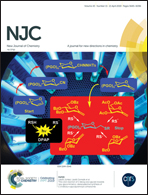Synthesis of 5-hydroxy-2-methyl-naphthalene-1,4-dione cocrystals with pyridine-3-carboxamide using electrospray technology: physicochemical characterization and in vitro non-everted rat intestinal absorption study
Abstract
Plumbagin (PL), 5-hydroxy-2-methyl-naphthalene-1,4-dione, a bioactive natural lipophilic molecule, has several pharmacological activities. However, its utility as a potential drug molecule has been limited due to low aqueous solubility and in turn bioavailability. Herein we report cocrystal synthesis of PL with nicotinamide (NIC, pyridine-3-carboxamide) coformer using electrospray technology in order to improve the biopharmaceutical properties of PL. A methanolic solution containing PL and NIC was electrosprayed to obtain PL–NIC cocrystals. The prepared cocrystals were characterized using powder X-ray diffractometry, differential scanning calorimetry, Fourier transform infrared spectroscopy, FT-Raman spectroscopy, scanning electron microscopy, saturation solubility and intrinsic dissolution studies. The bioavailability of the cocrystals was assessed using the non-everted rat intestinal sac model. Furthermore, histopathological studies of the rat intestinal sacs were performed to determine the integrity of the cocrystal treated intestine. Electrospray led to formation of sintered PL–NIC cocrystals as confirmed by PXRD, DSC, FTIR, and FT-Raman spectroscopy which showed two-fold enhancements in solubility of PL. The cocrystals showed three- and two-fold increases in dissolution rate in water and phosphate buffer pH 6.8, respectively. The flux and apparent permeability coefficient in the duodenum and ileum was nine-fold higher with no sign of intestinal tissue toxicity compared to PL. The study demonstrated the utility of electrospray technology to improve the pharmaceutical properties of bioactive PL and can be utilized for various clinically important water insoluble phytoconstituents in order to improve their biopharmaceutical properties.



 Please wait while we load your content...
Please wait while we load your content...